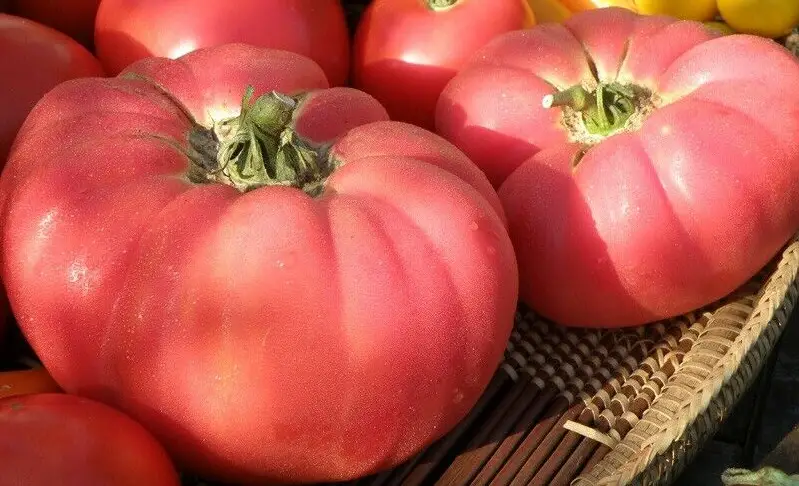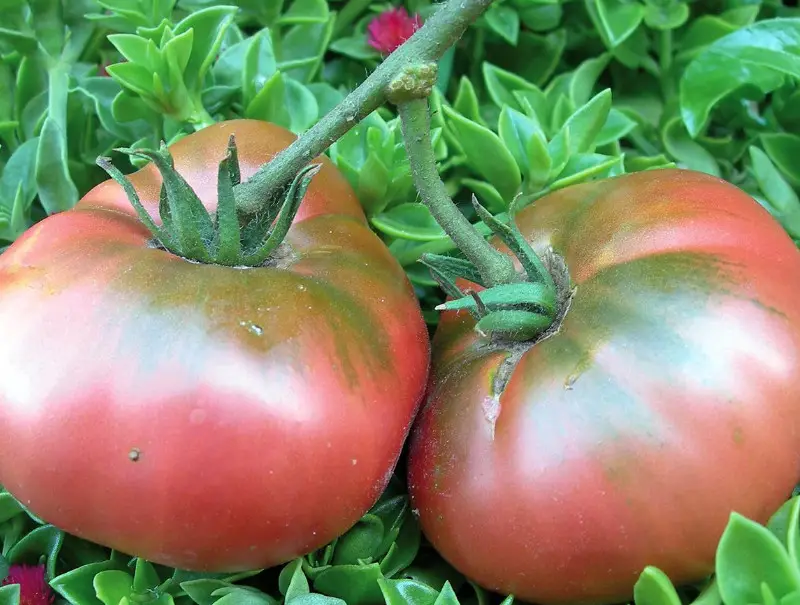Discover the essence of Pink Brandywine tomatoes through our detailed care and growing guide. Heirloom tomatoes such as the Pink Brandywine are highly prized for their mouthwatering taste and enticing appearance. Due to its limited availability, which occurs only in late summer and early autumn, it is also a specialty tomato variety.
About Pink Brandywine Tomato

The pink Brandywine tomato, scientifically known as Solanum lycopersicum ‘Brandywine’, is a popular cultivar in the Solanaceae family. With its striking appearance and delicate flavor, this tomato variety has garnered a loyal following among gardeners and culinary enthusiasts alike.
Growing 40 to 48 inches tall, with a width of about 18 inches, the Pink Brandywine tomato has impressive stature in the garden. It grows well in full sunlight. This sun-loving plant thrives in rich, well-drained soil with an acidic pH, ensuring optimal growth and fruit development.
One of the most notable characteristics of the Pink Brandywine tomato is its indeterminate bloom time. Unlike determinate varieties that produce fruit all at once, Pink Brandywine continues to bloom and fruit throughout the growing season, providing a steady supply of delicious tomatoes.
Adaptable to a variety of climates, this resilient cultivar thrives in USDA hardiness zones 2a to 11b. Its native area is believed to be due to its cultivated status, no specific native range has been identified.
How to Grow Pink Brandywine Tomatoes

Growing Pink Brandywine tomatoes requires attention to detail and care, but the reward of harvesting these flavorful fruits is well worth the effort. To ensure a successful growth journey, several key steps must be followed diligently.
Firstly, timing is crucial. Whether starting from seed indoors or purchasing young plants, the optimal time for planting Pink Brandywine tomatoes is when the nightly temperature consistently remains above 50°F. This temperature threshold ensures that the plants will thrive in their new environment without the risk of frost damage.
Selecting an ideal site for your tomatoes sets the stage for their growth and productivity. Choose a location that receives ample sunlight throughout the day, as Pink Brandywine tomatoes thrive in full sun. Additionally, the soil should be well-draining, slightly acidic, and rich in nutrients. While rich soil is beneficial, it’s essential to strike a balance to avoid excessive nitrogen, which may lead to vigorous foliage growth at the expense of fruit production.
When it comes to planting, attention to spacing, depth, and support is paramount. Unlike many plants where shallow planting is preferred, Pink Brandywine tomatoes benefit from being buried deeper, approximately 2/3 of the way down the stem. This deep planting encourages robust root development, providing stability to the top-heavy plants and facilitating nutrient uptake.
Regarding spacing, ensure each plant is given ample room to grow, typically 18 to 36 inches apart. This spacing allows for proper air circulation around each plant, reducing the risk of disease and simplifying plant maintenance. Alternatively, growing Pink Brandywine tomatoes in large pots provides flexibility and requires sturdy support structures to accommodate their size.
As the plants mature and begin to bear fruit, providing adequate support becomes essential. While tomato cages are a popular choice, they can hinder tasks such as pruning and harvesting. Instead, opting for bamboo stakes offers sturdy support while allowing easy access to the plant for maintenance activities.
Pink Brandywine Tomato Care Guide
Light
Ensuring proper light exposure is paramount when caring for Pink Brandywine tomatoes, as it directly impacts plant growth and fruit production. These luscious tomatoes thrive in sunlight, requiring a minimum of six to eight hours of full sun daily. Selecting a sunny spot for planting is crucial, as it promotes vigorous growth and encourages bountiful harvests.
For gardeners facing constraints in finding suitable soil conditions with adequate sunlight, growing Pink Brandywine tomatoes in pots offers a convenient alternative. Potted plants can be easily relocated to areas that meet the sunlight requirements, ensuring optimal conditions for growth and fruit development. This flexibility eliminates the need for a traditional garden setup while still yielding delicious tomatoes.
By prioritizing light exposure and providing the necessary sunlight, whether through traditional soil planting or container gardening, gardeners can cultivate thriving Pink Brandywine tomato plants that reward them with an abundance of flavorful fruits. With careful attention to this essential aspect of care, the journey from planting to harvest promises a fruitful and satisfying experience for tomato enthusiasts.
Soil
Creating optimal soil conditions is essential for the successful cultivation of Pink Brandywine tomatoes. These robust plants thrive in nutrient-rich, well-draining soil with a pH range of approximately 6.0 to 6.8. Prioritizing soil health sets the stage for vigorous growth and abundant fruit production.
To enhance soil fertility, incorporating compost at the time of planting is highly beneficial, particularly if the existing soil is deficient in nutrients. Compost provides essential organic matter, enriching the soil and fostering a favorable environment for plant growth. However, it’s crucial to strike a balance, as excessive nitrogen content in the soil can promote excessive foliage growth at the expense of flower and fruit development.
Conducting a soil test before planting is a prudent step to assess the soil’s nutrient levels and pH balance. This baseline evaluation enables gardeners to make informed decisions about soil amendments and adjustments necessary to optimize growing conditions for Pink Brandywine tomatoes. By addressing any deficiencies or imbalances early on, gardeners can ensure that their plants have access to the nutrients they need for robust growth and prolific fruiting.
Water
Watering is a critical aspect of caring for Pink Brandywine tomatoes, as it directly influences their flavor, juiciness, and overall health. Alongside sunlight, adequate watering is essential for promoting optimal growth and preventing issues such as cracked skin and pest infestations.
Pink Brandywine tomatoes, renowned for their exquisite flavor and juiciness, require consistent moisture to thrive. Typically, each tomato plant should receive approximately one to two inches of water per week. This ensures that the plants remain adequately hydrated, enabling them to develop succulent, flavorful fruits.
Failing to provide sufficient water can have detrimental effects on both the taste and quality of the tomatoes. Insufficient moisture may result in fruit with diminished flavor and texture, compromising the overall harvest. Moreover, inadequate watering can lead to issues such as cracked skin, which not only affects the appearance of the tomatoes but also creates entry points for pests and diseases.
Temperature and Humidity
Creating the ideal environment for Pink Brandywine tomatoes involves maintaining optimal temperature and humidity levels throughout the growing season. These tomatoes, like their counterparts, thrive in warm, moderately humid conditions, which are conducive to robust growth and abundant fruit production.
Temperature plays a crucial role in the development of Pink Brandywine tomatoes, with the ideal range falling between 60°F and 85°F. Within this temperature range, the plants can photosynthesize efficiently, promoting healthy growth and fruit ripening. Extreme temperatures, either too hot or too cold, can stress the plants and inhibit fruit set and development.
In addition to temperature, humidity levels also significantly impact Pink Brandywine tomato plants. While they appreciate moisture in the air, excessively high humidity can adversely affect pollination rates and fruit production. Aim for a humidity level between 65% and 85% to create an environment that supports healthy growth and fruit development without impeding pollination.
Maintaining optimal temperature and humidity levels requires careful monitoring and management, especially during periods of fluctuating weather. Providing adequate ventilation and air circulation can help regulate humidity levels and prevent issues such as fungal diseases. Additionally, shading techniques can be employed during hot summer days to protect the plants from excessive heat stress.
Fertilizer
Proper fertilization is essential for ensuring the healthy growth and abundant production of Pink Brandywine tomatoes throughout the growing season. As heavy feeders, these plants require supplemental nutrients to thrive, but choosing the right fertilizer can sometimes be challenging.
Testing the soil is a valuable first step in determining the specific nutrient needs of your tomato plants. However, observing the appearance of the plants can also provide valuable clues about potential deficiencies. Yellowing foliage, particularly if the plants are being adequately watered, may indicate a potassium deficiency. Conversely, a lack of foliage suggests a nitrogen deficiency, while a scarcity of blooms may signal a phosphorous deficiency.
When selecting a fertilizer, opt for one with a higher phosphorous number in the NPK formula, followed by a higher potassium number than nitrogen. This balanced formulation provides the essential nutrients needed for robust growth, flowering, and fruit development. Alternatively, commercially available tomato fertilizers are specifically formulated to meet the unique nutritional requirements of tomato plants, making them a convenient option for growers.
However, it’s crucial to exercise caution when fertilizing Pink Brandywine tomatoes. Over-fertilization can lead to adverse effects, such as nutrient imbalances, excessive foliage growth, or even damage to the plants. It’s better to err on the side of caution and under-fertilize than risk harming the plants with excessive nutrient levels.
Pruning
Pruning plays a crucial role in optimizing the growth and fruit production of tomato plants, including Pink Brandywine tomatoes. By directing the plant’s energy towards the most productive areas, pruning helps maximize both the flavor and abundance of the fruits.
To begin the pruning process, it’s essential to identify and remove suckers, which are small branches that emerge in the “V” crotches between the main stem and lateral branches. Using snippers or pruning shears, carefully prune away these suckers to prevent them from diverting energy away from fruit production. While some suckers may be saved for those interested in overwintering their plants, removing excess growth ensures that the plant’s resources are focused on developing robust fruits.
As the growing season progresses and the plant reaches its peak fruiting stage, it’s advisable to perform a more significant pruning known as topping off. This involves pruning the plant’s main stem directly above the uppermost blossom or fruit. By doing so, the plant’s energy is directed towards ripening the remaining fruits fully, ensuring they reach peak sweetness and ripeness late into the season.
Overwintering
Overwintering tomatoes is not a common practice for most gardeners due to the plant’s susceptibility to decreased yield over time. However, for those who grow tomatoes in pots, there are options to preserve the plants through the winter months.
One method involves bringing potted tomato plants indoors and overwintering them in a bright window of a warm location within the house. While this approach can help protect the plants from frost damage and extreme cold, it’s essential to recognize that the plant’s yield may gradually decrease with each passing year. Despite the decrease in productivity, overwintering tomatoes indoors can be a rewarding experience for those keen on extending the growing season and enjoying fresh tomatoes year-round.
Alternatively, gardeners can opt for a method that preserves the genetic makeup of the plant while avoiding the decline in yield. This involves propagating the tomato plant through cuttings, thereby creating new starters with the same genetic characteristics as the parent plant from the previous year. By propagating the plant through cuttings, growers can ensure continuity in their tomato production without compromising on yield or quality.
Ultimately, the decision to overwinter tomatoes depends on individual preferences and resources. While overwintering indoors can prolong the growing season, it’s essential to weigh the potential decrease in yield against the benefits of extended cultivation. Whether opting for indoor overwintering or propagating through cuttings, gardeners can explore various methods to preserve their tomato plants and continue enjoying fresh, homegrown produce year after year.
Harvesting Pink Brandywine Tomatoes
Harvesting Pink Brandywine tomatoes requires patience and attentiveness, as these delectable fruits mature later than other tomato varieties. Typically, you can expect your Pink Brandywine tomatoes to be ready for harvest around day 80 after planting. However, the key to determining ripeness lies not in counting days but in observing specific visual and tactile cues.
When your Pink Brandywine tomatoes are ripe for picking, they will exhibit several distinct characteristics. Look for fruit that lacks green spots, features a shiny skin, and boasts supple flesh. Unlike some tomato varieties, Pink Brandywine tomatoes don’t achieve a traditional bright red hue when ripe; instead, they display a subtle pinkish-red coloration. It’s essential to recognize this characteristic color variation to ensure optimal flavor and texture at harvest time.
When harvesting your Pink Brandywine tomatoes, handle the fruit with care to avoid damaging the plant or causing unnecessary stress. Rather than pulling the fruit directly from the vine, gently twist it until it detaches, or use a pair of pruners to cut the stem just above the fruit. This gentle approach helps preserve the integrity of the plant and minimizes the risk of bruising or damage to the fruit.
It’s important to manage expectations regarding crop yield when growing Pink Brandywine tomatoes. While these plants may not produce abundant yields compared to some other varieties, the fruits they do yield are substantial and bursting with flavor. Despite their perhaps unconventional appearance, Pink Brandywine tomatoes are celebrated for their exceptional taste, making them a prized addition to any garden or kitchen.
Planting Pink Brandywine Tomatoes in Pots
Growing Pink Brandywine tomatoes in pots offers flexibility and convenience, especially for gardeners with limited outdoor space or those seeking greater control over growing conditions. However, successful container gardening requires careful attention to several key factors to ensure optimal growth and fruit production.
When selecting a pot for your Pink Brandywine tomato plant, it’s crucial to choose one that provides ample space for root development. Opt for a large container that allows sufficient room for the plant to mature comfortably. A spacious pot not only accommodates the plant’s expanding root system but also promotes healthy growth and stability.
In addition to size, proper staking is essential when growing Pink Brandywine tomatoes in pots. Due to the confined space and potential for top-heaviness, securely stake the plant to prevent tipping or toppling over. Deep staking ensures stability and supports the plant as it grows, preventing potential damage or stress.
One of the most significant considerations when container gardening is watering. Unlike garden soil, potting mix in containers tends to dry out more quickly, requiring more frequent watering. As a general guideline, plan to water your Pink Brandywine tomato plant twice as often as you would if it were planted in the ground. Consistent moisture is crucial for maintaining optimal growth and fruit development, so be diligent in monitoring soil moisture levels and watering accordingly.
Typical Plant Diseases and Pests
Growing Pink Brandywine tomatoes comes with its own set of challenges, particularly when it comes to managing pests and plant diseases. While these heirloom varieties boast exceptional flavor, they may lack the disease resistance found in modern hybrid cultivars. As a result, vigilant monitoring and proactive care are essential to safeguarding the health and productivity of your Pink Brandywine plants.
Among the most common diseases to watch out for are blight, wilt, particularly verticillium wilt, and curly top. These diseases can pose significant threats to Pink Brandywine tomatoes, potentially affecting their growth and fruit production. However, with careful observation and timely intervention, you can mitigate the impact of diseases and help your tomatoes thrive. Regularly inspect your plants for symptoms of disease, such as yellowing leaves, wilting, or lesions, and take appropriate measures, such as pruning affected parts or applying fungicides, to prevent the spread of infection.
In addition to diseases, pests pose a constant threat to Pink Brandywine tomato plants. Insect infestations can wreak havoc on the plant’s physiology, disrupting normal growth processes and reducing flower and fruit production. When under attack, tomato plants produce a compound called systemin, which helps strengthen the plant’s defenses but can also impede overall growth. To defend against pests, it’s crucial to maintain a proactive approach. Keep a close eye on your plants for signs of pest activity and promptly remove any pests you encounter, either manually or with the use of appropriate insecticides.
How to Grow Pink Brandywine Tomatoes From Seed
Growing Pink Brandywine tomatoes from seed can be a rewarding experience, allowing you to witness the entire lifecycle of these flavorful heirloom tomatoes. Here’s a step-by-step guide to help you successfully grow Pink Brandywine tomatoes from seed:
- Selecting Seeds: Start by acquiring high-quality Pink Brandywine tomato seeds from a reputable source. Look for seeds that are labeled as organic and non-GMO for the best results.
- Seed Starting Mix: Choose a well-draining seed starting mix or create your own by combining equal parts of peat moss, vermiculite, and perlite. Fill seedling trays or small pots with the seed starting mix, leaving about half an inch of space from the top.
- Planting Seeds: Plant the Pink Brandywine tomato seeds approximately 1/4 inch deep in the seed starting mix. Place one or two seeds in each planting cell or pot, spacing them evenly.
- Moisture and Warmth: After planting the seeds, water the soil thoroughly until it’s evenly moist but not waterlogged. Cover the trays or pots with a clear plastic dome or plastic wrap to create a mini greenhouse effect, retaining moisture and warmth. Place the trays or pots in a warm location with temperatures around 70-80°F (21-27°C) to encourage germination.
- Germination: Pink Brandywine tomato seeds typically germinate within 7 to 14 days under optimal conditions. Keep the soil consistently moist during this period, ensuring it doesn’t dry out.
- Light: Once the seeds have germinated and seedlings emerge, remove the plastic covering and place the trays or pots in a location with plenty of bright, indirect sunlight. Alternatively, you can use grow lights to provide adequate illumination for healthy seedling growth.
- Transplanting: After the seedlings have developed their first set of true leaves and are sturdy enough to handle, it’s time to transplant them into larger containers or into the garden. Choose containers with drainage holes or prepare garden beds with well-draining soil.
- Hardening Off: Before transplanting seedlings outdoors, it’s essential to gradually acclimate them to outdoor conditions through a process called hardening off. Start by exposing the seedlings to outdoor conditions for short periods each day, gradually increasing the duration and intensity of exposure over the course of a week.
- Planting Outdoors: When the danger of frost has passed and the seedlings have been hardened off, transplant them into the garden or larger containers. Space the plants approximately 18 to 36 inches apart to allow for proper growth and airflow.
- Care and Maintenance: Provide consistent moisture, ensuring the soil remains evenly moist but not waterlogged. Monitor for signs of pests and diseases, and take appropriate action if necessary. Additionally, consider providing support such as stakes or cages as the plants grow to prevent sprawling and support heavy fruit clusters.
How to Grow Pink Brandywine Tomatoes from Cuttings
Growing Pink Brandywine tomatoes from cuttings can be an effective way to propagate these flavorful heirloom tomatoes while preserving their desirable traits. Here’s a step-by-step guide to help you successfully grow Pink Brandywine tomatoes from cuttings:
- Selecting Cuttings: Start by selecting healthy and disease-free Pink Brandywine tomato plants from which to take cuttings. Choose mature plants with vigorous growth and plenty of foliage.
- Preparation: Using clean and sharp pruning shears or scissors, carefully take cuttings from the selected Pink Brandywine tomato plants. Cuttings should be taken from lateral branches rather than the main stem. Each cutting should be approximately 4 to 6 inches long and include at least two sets of leaves.
- Removing Leaves: Strip the lower leaves from each cutting, leaving only a few leaves at the top. This reduces moisture loss and encourages root development.
- Rooting Hormone (Optional): To enhance the rooting process, you may choose to dip the cut end of each cutting into rooting hormone powder. This helps stimulate root growth and improves the chances of successful propagation.
- Planting Cuttings: Fill small pots or seedling trays with a well-draining potting mix. Make small holes in the soil with a pencil or similar tool and gently insert the cut end of each cutting into the holes. Firmly press the soil around the base of the cutting to ensure good contact.
- Watering: Water the cuttings thoroughly after planting to settle the soil and provide moisture. Ensure that the soil remains evenly moist but not waterlogged throughout the rooting process.
- Warmth and Humidity: Place the pots or trays containing the cuttings in a warm and humid environment to encourage root development. You can create a mini greenhouse effect by covering the cuttings with a clear plastic dome or plastic wrap. Keep the cuttings in a location with temperatures around 70-80°F (21-27°C).
- Rooting: Over the next few weeks, monitor the cuttings regularly for signs of new growth and root development. Roots should begin to form within 2 to 4 weeks under optimal conditions.
- Transplanting: Once the cuttings have developed a healthy root system, they can be transplanted into larger pots or directly into the garden. Choose a location with well-draining soil and plenty of sunlight for optimal growth.
- Care and Maintenance: Provide regular watering and monitor the plants for signs of pests or diseases. Consider providing support such as stakes or cages as the plants grow to support heavy fruit clusters.
Conclusion
Mastering the cultivation of Pink Brandywine tomatoes offers a journey rich in flavor and satisfaction. By following the detailed care and growing guide provided, gardeners can unlock the secrets to nurturing these prized heirloom tomatoes, ensuring a bountiful harvest and a culinary delight for seasons to come.






